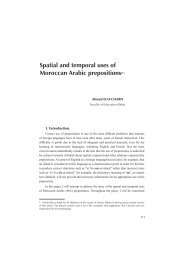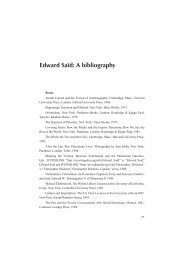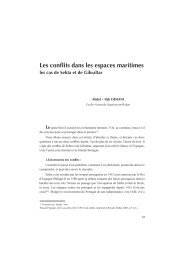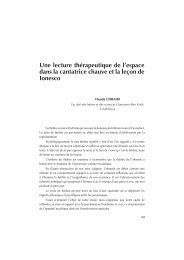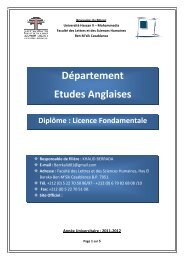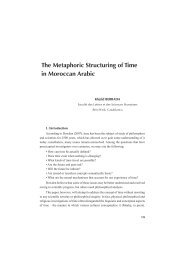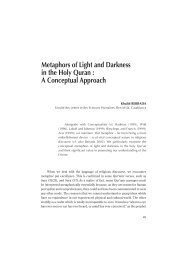Lahlou Khalid - Faculté des Lettres et des Sciences Humaines Ben ...
Lahlou Khalid - Faculté des Lettres et des Sciences Humaines Ben ...
Lahlou Khalid - Faculté des Lettres et des Sciences Humaines Ben ...
Create successful ePaper yourself
Turn your PDF publications into a flip-book with our unique Google optimized e-Paper software.
A book ReviewA book ReviewTeaching by Principles: an InteractiveApproach to Language Pedagogy,H. Douglas Brown<strong>Khalid</strong> LAHLOUFaculté <strong>des</strong> <strong>L<strong>et</strong>tres</strong> <strong>et</strong> <strong>des</strong> <strong>Sciences</strong> <strong>Humaines</strong>, <strong>Ben</strong> M’sik, CasablancaThe following is excerpted from H. Douglas Brown, Teaching by Principles:an Interactive Approach to Language Pedagogy, 2nd ed., Addison-WesleyLongman, Inc., 2001. These excerpts are followed by some comments which Ihave tried to include in order to make things clearer to the reader.Brown maintains that English language teaching has moved into a postm<strong>et</strong>hodologicalera and that we, teachers, should base our pedagogy on principlesthat will “form the core of an approach to language teaching” (pp. 54-55). Hehas divided twelve principles into three categories: cognitive, affective, andlinguistic. These categories are presented below along with Brown’s definitionsor statements regarding the principles.Cognitive PrinciplesAutomaticity: «Efficient second language learning involves a timelymovement of the control of a few language forms into the automatic processing89
Basamatof a relatively unlimited number of language forms. Over analyzing language,thinking too much about its forms, and consciously lingering on rules oflanguage all tend to impede this graduation to automaticity» (p. 56).Meaningful Learning: «Meaningful leaning will lead toward b<strong>et</strong>ter longtermr<strong>et</strong>ention than rote learning» (p. 57). What Brown means by «meaningfullearning» is using activities in class that targ<strong>et</strong> and incorporate students’ needs,personal interests, and goals.The Anticipation of Reward: “Human beings are universally driven to act,or ‘behave,’ by the anticipation of some sort of reward - tangible or intangible,short term or long term - that will ensue as a result of the behavior” (p. 58).Intrinsic Motivation: «The most powerful rewards are those that areintrinsically motivated within the learner. Because the behavior stems fromneeds, wants, or <strong>des</strong>ires within oneself, the behavior itself is self-rewarding;therefore, no externally administered reward is necessary» (p. 59). Thisstatement seems to contradict the previous statement about «anticipation ofreward». However, these statements are complementary, not exclusive.Strategic Investment: “Successful mastery of the second language willbe due to a large extent to a learner’s own personal ‘investment’ of time, effort,and attention to the second language in the form of an individualized battery ofstrategies for comprehending and producing the language” (p. 60).Affective PrinciplesLanguage Ego: «As human beings learn to use a second language, they alsodevelop a new mode of thinking, feeling, and acting-a second identity. The new‘language ego”, intertwined with the second language, can easily create within thelearner a sense of fragility, a defensiveness, and a raising of inhibitions» (p. 61).Self-Confidence: «Learners’ belief that they indeed are fully capable ofaccomplishing a task is at least partially a factor in their eventual success inattaining the task» (p. 62).Risk-Taking: «Successful language learners, in their realistic appraisal ofthemselves as vulnerable beings y<strong>et</strong> capable of accomplishing tasks, must bewilling to become ‘gamblers’ in the game of language, to attempt to produce andto interpr<strong>et</strong> language that is a bit beyond their absolute certainty» (p. 63).The Language-Culture Connection: “Whenever you teach a language, youalso teach a complex system of cultural customs, values, and ways of thinking,90
A book Reviewfeeling, and acting” (p. 64). . . . “Especially in ‘second’ language learning contexts,the success with which learners adapt to a new cultural milieu will affect theirlanguage acquisition success, and vice versa, in some possibly significant ways”(p. 65).Linguistic PrinciplesThe Native Language Effect: “The native language of learners exerts astrong influence on the acquisition of the targ<strong>et</strong> language system. While thatnative system will exercise both facilitating and interfering effects on theproduction and comprehension of the new language, the interfering effects arelikely to be the most salient” (p. 66).Interlanguage: “Second language learners tend to go through a systematicor quasi-systematic developmental process as they progress to full comp<strong>et</strong>encein the targ<strong>et</strong> language Successful interlanguage development is partially a resultof utilizing feedback from others” (p. 67).Communicative Comp<strong>et</strong>ence: “Given that communicative comp<strong>et</strong>ence is thegoal of a language classroom, instruction needs to point toward all its components:organizational, pragmatic, strategic, and psychomotor. Communicative goalsare best achieved by giving the attention to language use and not just usage,to fluency and not just accuracy, to authentic language and contexts, and tostudents’ eventual need to apply classroom learning to previously unrehearsedcontexts in the real world” (p. 69).91




